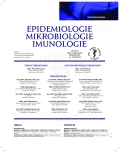The prevalence of antibodies against Hepatitis E Virus in the Czech Republic: serological survey
Authors:
V. Němeček 1; P. Butovičová 1; M. Malý 1; Petr Dítě 2; M. Veřtátová 1; I. Vodičková 1; B. Kříž 1,3
Authors‘ workplace:
Státní zdravotní ústav, Praha
1; Univerzita obrany, Brno
2; Univerzita Karlova, 3. lékařská fakulta, Praha
3
Published in:
Epidemiol. Mikrobiol. Imunol. 66, 2017, č. 1, s. 3-7
Category:
Original Papers
Overview
Aim:
To determine the prevalence of antibodies against hepatitis E virus in the general population of the Czech Republic of age 15 to 64, to analyse the age and sex distribution of these antibodies, and to evaluate the benefit of the immunoblot test for the confirmation of the specificity of the enzyme immunoassay (EIA) screening test.
Material and methods:
Sera from the last available multipurpose serological survey conducted in 2001 were tested. Anti-HEV IgG was detected by the RecomWell HEV IgG EIA test (Mikrogen Diagnostik, Germany). The immunoblot assay RecomLine HEV IgG/IgM (Mikrogen Diagnostik, Germany) was used for confirmation.
Results:
Using the RecomWell IgG EIA test, anti-HEV IgG reactivity was found in 115 (6.7%) of 1715 sera. No significant difference in the anti-HEV IgG reactivity was found between men 58 (6.9%) and women 57 (6.6%). The prevalence of anti-HEV IgG increased with age from 3.5% in the age group 15–24 years to 16.8% in 55-64-year-olds.
Conclusions:
The prevalence of hepatitis E IgG antibodies determined in the serological survey in the age group 15–64 years was 6.7%. Recalculated for the general population of the Czech Republic, the prevalence was 8.6%. The prevalence of anti-HEV antibodies increased with age, reaching a peak of 16.8% in the age group 55–64 years. The prevalence was not significantly different between men and women.
Using the immunoblot RecomLine IgG test for the confirmation of the specificity of the screening test in the seroprevalence study was not of clear benefit.
KEYWORDS:
hepatitis E virus – anti-HEV – prevalence – EIA – immunoblot
Sources
1. Lu L, Li C, Hagedorn CH. Phylogenetic analysis of global hepatitis E virus sequences: genetic diversity, subtypes and zoonosis. Rev Med Virol, 2006;16:5–36.
2. Hoofnagle JH, Nelson KE, Purcell RH. Hepatitis E. N Engl J Med, 2012;367:1237–1244.
3. Pavio N, Meng XJ, Renou C. Zoonotic hepatitis E: animal reservoirs and emerging risks. Vet Res, 2010;41:46.
4. Boxall E, Herborn A, Kochethu G, Pratt G, Adams D, Ijaz S, Teo CG. Transfusion – transmitted hepatitis E in a 'nonhyperendemic' country. Transfus Med, 2006;16:79–83.
5. Bihl F, Negro F. Chronic hepatitis E in the immunosuppressed: a new source of trouble? J Hepatol, 2009;50:435–437.
6. Huang S, Zhang X, Jiang H, Yan Q, Ai X, Wang Y, Cai J, Jiang L, Wu T, Wang Z, Guan L, Shih JW, Ng MH, Zhu F, Zhang J, Xia N. Profile of acute infectious markers in sporadic hepatitis E. PLoS One, 2010;5:e13560.
7. Chadha MS, Walimbe AM, Arankalle VA. Retrospective serological analysis of hepatitis E patients: a long-term follow-up study. J Viral Hepat, 1999;6:457–461.
8. Rapicetta M, Kondili LA, Pretolani S, Stroffolini T, Chionne P, Villano U, Madonna E, Casali F, Gasbarrini G. Seroprevalence and anti-HEV persistence in the general population of the Republic of San Marino. J Med Virol, 1999;58:49–53.
9. Khuroo MS, Kamili S, Dar MY, Moecklii R, Jameel S. Hepatitis E and long-term antibody status. Lancet, 1993;341:1355.
10. Wenzel JJ, Preiss J, Schemmerer M, Huber B, Jilg W. Test performance characteristics of Anti-HEV IgG assays strongly influence hepatitis E seroprevalence estimates. J Infect Dis, 2013;207:497–500.
11. Echevarria JM. Light and Darkness: Prevalence of Hepatitis E Virus Infection among the General Population. Scientifica (Cairo), 2014:481016.
12. Bendall R, Ellis V, Ijaz S, Ali R, Dalton H. A comparison of two com-mercially available anti-HEV IgG kits and a re-evaluation of anti-HEV IgG seroprevalence data in developed countries. J Med Virol, 2010;82:799–805.
13. Emerson SU, Clemente-Casares P, Moiduddin N, Arankalle VA, Torian U, Purcell RH. Putative neutralization epitopes and broad cross-genotype neutralization of Hepatitis E virus confirmed by a quantitative cell-culture assay. J Gen Virol, 2006;87:697–704.
14. Mast EE, Alter MJ, Holland PV, Purcell RH. Evaluation of assays for antibody to hepatitis E virus by a serum panel. Hepatitis E Virus Antibody Serum Panel Evaluation Group. Hepatology, 1998;27:857–861.
15. Ferguson M, Walker D, Mast E, Fields H. Report of a collaborative study to assess the suitability of a reference reagent for antibodies to hepatitis E virus. Biologicals, 2002;30:43–48.
16. Kamar N, Dalton HR, Abravanel F, Izopet J. Hepatitis E virus infec-tion. Clin Microbiol Rev, 2014;27:116–138.
17. Strakova P, Kriz B, Rudolf I, Hubalek Z. Seroprevalence study of hepatitis E virus infection in two districts of the Czech Republic. Epidemiol Mikrobiol Imunol, 2014;63:92–94.
18. Legrand-Abravanel F, Kamar N, Sandres-Saune K, Lhomme S, Mansuy JM, Muscari F, Sallusto F, Rostaing L, Izopet J. Hepatitis E virus infection without reactivation in solid-organ transplant recipients, France. Emerg Infect Dis, 2011;17:30–37.
19. Faber MS, Wenzel JJ, Jilg W, Thamm M, Hohle M, Stark K. Hepatitis E virus seroprevalence among adults, Germany. Emerg Infect Dis, 2012;18:1654–1657.
20. Schnegg A, Burgisser P, Andre C, Kenfak-Foguena A, Canellini G, Moradpour D, Abravanel F, Izopet J, Cavassini M, Darling KE. An analysis of the benefit of using HEV genotype 3 antigens in detecting anti-HEV IgG in a European population. PLoS One, 2013;8:e62980.
Labels
Hygiene and epidemiology Medical virology Clinical microbiologyArticle was published in
Epidemiology, Microbiology, Immunology

2017 Issue 1
Most read in this issue
- Management of acute anaphylaxis in clinical practice in the context of the guidelines
- The prevalence of antibodies against Hepatitis E Virus in the Czech Republic: serological survey
- Foodborne botulism – a re-emerging public health challenge
- Infectious diseases and laboratory diagnosisin the Terezin Jewish Ghetto
